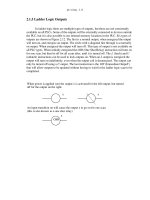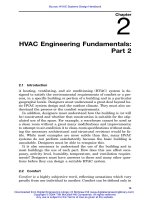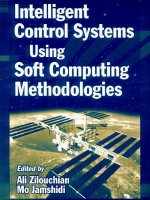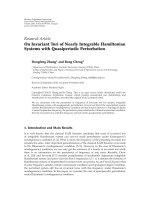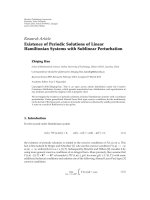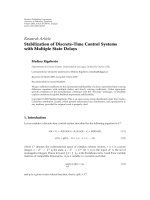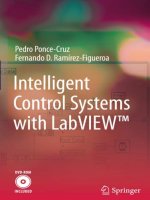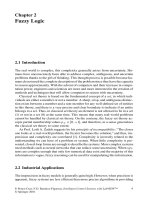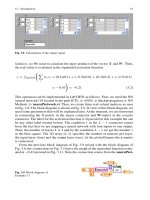Intelligent Control Systems with LabVIEW 2 ppt
Bạn đang xem bản rút gọn của tài liệu. Xem và tải ngay bản đầy đủ của tài liệu tại đây (505.81 KB, 22 trang )
Chapter 2
Fuzzy Logic
2.1 Introduction
The real world is complex; this complexity generally arises from uncertainty. Hu-
mans have unconsciously been able to address complex, ambiguous, and uncertain
problems thanks to the gift of thinking. This thought process is possible because hu-
mans do not need the complete description of the problem since they have the capacity
to reason approximately. With the advent of computers and their increase in compu-
tation power, engineers and scientists are more and more interested in the creation of
methods and techniques that will allow computers to reason with uncertainty.
Classical set theory is based on the fundamental concept of a set, in which indi-
viduals are either a member or not a member. A sharp, crisp, and ambiguous distinc-
tion exists between a member and a non-member for any well-defined set of entities
in this theory, and there is a very precise and clear boundary to indicate if an entity
belongs to a set. Thus, in classical set theory an element is not allowed to be in a set
(1) or not in a set (0) at the same time. This means that many real-world problems
cannot be handled by classical set theory. On the contrary, the fuzzy set theory ac-
cepts partial membership values
f
2 Œ0; C1, and therefore, in a sense generalizes
the classical set theory to some extent.
As Prof. Lotfi A. Zadeh suggests by his principle of incompatibility:“Thecloser
one looks at a real-world problem, the fuzzier becomes the solution,” and thus, im-
precision and complexity are correlated [1]. Complexity is inversely related to the
understanding we can have of a problem or system. When little complexity is pre-
sented, closed-loop forms are enough to describe the systems. More complex systems
need methods such as neural networks that can reduce some uncertainty. When sys-
tems are complex enough that only few numerical data exist and the majority of this
information is vague, fuzzy reasoning can be used for manipulating this information.
2.2 Industrial Applications
The imprecision in fuzzy models is generally quite high. However, when precision is
apparent, fuzzy systems are less efficient than more p recise algorithms in providin g
P. Ponce-Cruz, F. D. Ramirez-Figueroa, Intelligent Control Systems with LabVIEW™ 9
© Springer 2010
10 2 Fuzzy Logic
us with the best understanding of the system. In the following examples, we explain
how many industries have taken advantage o f the fuzzy theory [2].
Example 2.1. Mitsubishi manufactures a fuzzy air conditioner. While conventional
air conditioners use on/off controllers that work and stop working based on a range
of temperatures, the Mitsubishi machine takes advantage of fuzzy rules; the ma-
chine operates smoother as a result. The machine becomes mistreated by sudden
changes of state, more consistent room temperatures are achieved, and less energy
is consumed. These were first released in 1989. ut
Example 2.2. Fisher, Sanyo, Panasonic, and Canon make fuzzy video cameras.
These have a digital image stabilizer to r e move hand jitter, and the video camera
can determine the best focus and lightning. Fuzzy decision making is used to control
these actions. The present image is compared with the previous frame in memory,
stationary objects are detected, and its shift coordinates are computed. This shift is
subtracted from the image to compensate for the hand jitter. ut
Example 2.3. Fujitec and Toshiba have a fuzzy scheme that evaluates the passenger
traffic and the elevator variables to determine car announcement and stopping time.
This helps reduce the waiting time and improves the efficiency and reliability of the
systems. The patent for this type of system was issued in 1998. ut
Example 2.4. The automotive industry has also taken advantage of the theory. Nis-
san has had an anti-lock braking system since 1997 that senses wheel speed, road
conditions, and driving pattern, and the fuzzy ABS determines the braking action,
with skid control [3]. ut
Example 2.5. Since 1988 Hitachi has turned over the control of the Sendai subway
system to a fuzzy system. It has reduced the judgment on errors in acceleration and
braking by 70%. The Ministry of International Trade and Industry estimates that in
1992 Japan produced about $2 billion worth of fuzzy products. US and European
companies still lag far behind. The market of products is enormous, ranging from
fuzzy toasters to fuzzy golf diagnostic systems. ut
2.3 Background
Prof. Lotfi A. Zadeh introduced the seminal paper on fuzzy sets in 1965 [4]. Since
then, many developments have taken place in different parts of the world. Since the
1970s Japanese researchers have been the primary force in the implementation o f
fuzzy theory and now have thousands of patents in the area.
The world response to fuzzy logic has been varied. On the one hand, western
cultures are mired with the yes or no, guilty or not guilty, of the binary Aristotelian
logic world and their interpretation o f the fuzziness causes a conflict because they
are given a negative connotation. On the o ther hand, Eastern cultures easily ac-
commodate the concept of fuzziness because it does not imply d isorganization and
imprecision in their languages as it does in English.
2.4 Foundations of Fuzzy Set Theory 11
2.3.1 Uncertainty in Information
The uncertainties in a problem should be carefully studied by engineers prior to se-
lecting an appropriate method to represent the uncertainty and to solve the problem.
Fuzzy sets provide a way that is very similar to the human reasoning system. In
universities most of the material taught in engineering classes is based on the pre-
sumption that knowledge is deterministic. Then when students graduate and enter
“the real world,” they fear that they will forget the correct formula.
However, one must realize that all information contains a certain degree of un-
certainty. Uncertainty can arise from many factors, such as complexity, randomness,
ignorance, or imprecision. We all use vague information and imprecision to solve
problems. Hence, our computational methods should be able to represent and ma-
nipulate fuzzy and statistical uncertainties.
2.3.2 Concept of Fuzziness
In our everyday language we use a great deal of vagueness and imprecision, that can
also be called fuzziness. We are concerned with how we can represent and manipu-
late inferences with this kind of information. Some examples are: a person’s size is
tall, and their age is classified as young.
Terms such as tall and young are fuzzy because they cannot be crisply defined,
although as humans we use this information to make decisions. When we want to
classify a person as tall or young it is impossible to decide if the person is in a set or
not. By giving a degree of pertinence to the subset, no information is lost when the
classification is made.
2.4 Foundations of Fuzzy Set Theory
Mathematical foundations of fuzzy logic rest in fuzzy set theory, which can be seen
as a generalization of classical set theory. Fuzziness is a language concept; its main
strength is its vagueness using symbols and defining them.
Consider a set of tables in a lobby. In classical set theory we would ask: Is it
a table? And we would have only two answers, yes or no. If we code yes with a 1
and no with a 0 then we would have the pair of answers as {0,1}. At the end we
would collect all the elements with 1 and have the set of tables in the lobby.
We may then ask what objects in the lobby can function as a table? We could
answer that tables, boxes, desks, among others can function as a table. The set is
not uniquely defined, and it all depends on what we mean by the word function.
Words like this have many shades of meaning and depend on the circumstances
of the situation. Thus, we may say that the set o f objects in the lobby that can
12 2 Fuzzy Logic
function as a table is a fuzzy set, because we have not crisply defined the cri-
teria to define the membership of an element to the set. Objects such as tables,
desks, boxes may function as a table with a certain degree, although the fuzziness
is a feature of their representation in symbols and is normally a property of models,
or languages.
2.4.1 Fuzzy Sets
In 1965 Prof. Lotfi A. Zadeh introduced fuzzy sets, where many degrees of mem-
bership are allowed, and indicated with a number between 0 and 1. The point of
departure for fuzzy sets is simply the generalization of the valuation set from the
pair of numbers {0,1} to all the numbers in [0,1]. This is called a membership func-
tion and is denoted as
A
.x/, and in this way we have fuzzy sets.
Membership functions are mathematical tools for indicating flexible membership
to a set, modeling and quantifying the meaning of symbols. They can represent
a subjective notion of a vague class, such as chairs in a room, size of people, and
performance among others. Commonly there are two ways to denote a fuzzy set. If
X is the universe of discourse, and x is a particular element of X, then a fuzzy set
A defined on X may be written as a collection of ordered pairs:
A D
f
.x;
A
.x//
g
x 2 X; (2.1)
where each pair .x;
A
.x// is a singleton. In a crisp set singletons are only x,but
in fuzzy sets it is two things: x and
A
.x/. For example, the set A may be the
collection of the following integers, as in (2.2):
A D
f
.1; 1:0/; .3; 0:7/; .5; 0:3/
g
: (2.2)
Thus, the second element of A expresses that 3 belongs to A to a degree of 0.7.
The support set of a fuzzy set A is the set of elements that have a membership
function different from zero. Alternative notations for the fuzzy sets are summa-
tions or integrals to indicate the union of the fuzzy set, depending if the uni-
verse of discourse is discrete or continuous. The notation of a fuzzy set with
a discrete universe o f discourse is A D
P
x
i
2X
A
.x
i
/=x
i
which is the union
of all the singletons. For a continuous universe of discourse we write the set as
A D
R
X
A
.x/=x, where the integral sign indicates the union of all
A
.x/=x
singletons.
Now we will show how to create a triangular membership function using the
Intelligent Control Toolkit for LabVIEW (ICTL). This triangular function must be
between 0 and 3 with the maximum point at 1.5; we can do this using the triang-
function.vi. To evaluate and graph the function we must use a 1D array that can be
easily created using the rampVector.vi. We can find this VI (as shown in Fig. 2.1)
2.4 Foundations of Fuzzy Set Theory 13
Fig. 2.1 Fuzzy function location on the ICTL
Fig. 2.2 Construction and
evaluation of a triangular
membership
in the fuzzy logic palette of the toolkit. The block diagram of the program that
will create and evaluate the triangular function is shown in Fig. 2.2. The triangular
function will be as the one shown in Fig. 2.3.
14 2 Fuzzy Logic
Fig. 2.3 Triangular membership function created with the ICTL
2.4.2 Boolean Operations and Terms
The two-valued logic is called Boolean algebra, named after George Boole, a nine-
teenth century mathematician and logician. In this algebra there are only three basic
logic operations: NOT :, AND ^ and OR _. It is also common to use the symbols:
, ,andC. Boolean algebraic formulas can be described b y a truth table, where all
the variables in the formula are the inputs and the value of the formula is the output.
Conversely, a formula can be written from a truth table. For example the truth table
for AND is shown in Table 2.1.
Complex Boolean formulas can be reduced to simpler equivalent ones using
some properties. It is important to note that some rules of the Boolean algebra are
the same as those of the ordinary algebra (e. g., a 0 D 0, a 1 D a), but o thers
are quite different (a C 1 D 1). Table 2.2 shows the most important properties of
Boolean algebra.
Table 2. 1 Truth table of the AND Boolean operation
xyx^ y
000
010
100
111
2.4 Foundations of Fuzzy Set Theory 15
Table 2. 2 The m ost important properties of Boolean algebra
Laws Formulas
Characteristics a 0 D 0, a 1 D a, a C0 D a and a C1 D 1
Commutative law a C b D b Ca and a b D b a
Associative law a C b Cc D a C.b C c/ D .a C b/ C c
a b c D a .b c/ D .a b/ c
Distributive law a .b Cc/ D a b Ca c
Idempotence a a D a and a Ca D a
Negation
a D a
Inclusion a
a D 0anda Ca D 1
Absorptive law a C a b D a and a .a C b/ D a
Reflective law a C
a b D aCb, a .a Cb/ D a b,anda b Ca b c D ab Cb c
Consistency a b Ca
b D a and .a Cb/
a C b
Á
D a
De Morgan’s law
a b D a Cb and a C b D a b
2.4.3 Fuzzy Operations and Terms
Operations such as intersection and union are defined through the min .^/ and max
._/ operators, which are analogous to product and sum in algebra. Formally the
minandmaxofanelement,whereÁ stands for “by definition,” are denoted by
(2.3) and (2.4):
a
^
b
D min .
a
;
b
/ Á
a
if and only if
a
Ä
b
b
if and only if
a
>
b
(2.3)
a
_
b
D max .
a
;
b
/ Á
a
if and only if
a
b
b
if and only if
a
<
b
: (2.4)
The most important fuzzy operations are shown in Table 2.3. The following func-
tions in (2.5) are two fuzzy sets, a triangular and a bell-shaped membership function:
triangle
.x/ D
(
2.x1/
7
I 1 Ä x Ä
9
2
2.x8/
7
I
9
2
Ä x Ä 8
bell
.x/ D
1
1 C
ˇ
ˇ
x0:1
3
ˇ
ˇ
6
: (2.5)
The diagrams for the membership functions can be found in Fig. 2.4, a union be-
tween the triangular and bell functions is shown in Fig. 2.5, and an intersection is
shown in Fig. 2.6. The bell function and the complement are shown in Fig. 2.7.
16 2 Fuzzy Logic
Fig. 2.4 Diagram of triangular and bell membership functions
Fig. 2.5 Union of functions
Fig. 2.6 Intersection of sets
2.4 Foundations of Fuzzy Set Theory 17
Fig. 2.7 Bell and complement of the bell function
Table 2. 3 The most important fuzzy operations
Empty fuzzy set It is empty if its membership
function is zero e verywhere in
the universe of discourse.
A Á;
if
A
.x/ D 0; 8x 2 X
Normal fuzzy set It is normal if there is at least
one element in the universe of
discourse where its membership
function equals one.
A
.x
a
/ D 1
Union of two fuzzy sets The union of two fuzzy sets A
and B over the same universe
of discourse X is a fuzzy set
A [B in X with a membership
function which is the maximum
of the grades of membership of
every x and A and B:
This operation is related to the
OR operation in fuzzy logic:
A[B
.x/ Á
A
.x/ _
B
.x/
Intersection of fuzzy sets It is the minimum of the grades
of ev ery x in X to the sets A
and B.Theintersection of two
fuzzy sets is related to the AND.
A\B
.x/ Á
A
.x/ ^
B
.x/
Complement of a fuzzy set The complement of a fuzzy set
A is denoted as
N
A.
N
A
.x/ Á 1
A
.x/
Product of t wo fuzzy sets A B denotes the product of two
fuzzy sets with a membership
function that equals the alge-
braic product of the membership
function A and B.
AB
.x/ Á
A
.x/
B
.x/
18 2 Fuzzy Logic
Table 2. 3 (continued)
Power of a fuzzy set The ˇ power of A (A
ˇ
)has
the equivalence to linguistically
modify the set with VERY.
A
ˇ
.x/ Á Œ
A
.x/
ˇ
Concentration Squaring the set is called con-
centration CON.
CON .ˇ/
.x/ Á .
A
.x//
2
Dilation Taking the square root is called
dilation or DIL.
DIL.A/
.x/ Á
p
A
.x/
2.4.4 Properties of Fuzzy Sets
Fuzzy sets are useful in performing operations using membership functions. Proper-
ties listed in Table 2.4 are valid for crisp and fuzzy sets, although some are specific
for fuzzy sets only. Sets A, B,andC must be considered as defined over a common
universe of discourse X .
All of these properties can be expressed using the membership function of the
sets involved and the definitions of union, intersection and complement. De Mor-
gan’s law says that the intersection of the complement of two fuzzy sets equal the
complement of their union. There are also some properties not valid for fuzzy sets
such as the law of contradiction and the law of the excluded middle.
Table 2. 4 The most important fuzzy properties
Double negation law
N
A
D A
Idempotency A [A D AA\ A D A
Commutativity A \B D B \AA[B D B [ A
Associative p roperty .A [B/ [ C D A [.B [C/
.A \B/ \ C D A \.B \C/
Distributive property A [ .B \ C/ D .A [ B/ \ .A [ C/A \
.B [ C/ D .A \B/ [.A \ C/
Absorption A \.A [ B/ D A
A [.A \ B/ D A
De Morgan’s laws
A [B D A \ B
A \B D A [ B
2.4.5 Fuzzification
This process is mainly used to transform a crisp set to a fuzzy set, although it can
also be used to increase the fuzziness of a fuzzy set. A fuzzifier function F is used to
control the fuzziness of the set. As an example the fuzzy set A can be defined with
2.4 Foundations of Fuzzy Set Theory 19
Fig. 2.8 Diagram of the Bell-
Function.vi
Fig. 2.9 Different forms of bell membership functions
the function in (2.6):
A
.x/ D
1
1 C
ˇ
ˇ
xc
a
ˇ
ˇ
2b
; (2.6)
where x is any positive real number, and the parameters a, b, c shape the form of
the bell membership function. The fuzzy set A can be written as:
A Á
Z
x
"
1
1 C
ˇ
ˇ
xc
a
ˇ
ˇ
2b
#
=x : (2.7)
This is an example of the bell function with different parameters using the ICTL. We
can use the Bell-Function.vi (shown in Fig. 2.8) to create the membership functions.
The a, b and c parameters can be changed and the form of the function will be
different. The membership functions are shown in Fig. 2.9. The code that generates
the membership functions is shown in Fig. 2.10. Basically, a 1D array is used to
evaluate each one of the bell functions and generate their different forms.
Example 2.6. The productivity of people can be modeled using a bell function. It
will increase depending on their age, then it will remain on the top for several
years and it will decrease when the person reaches a certain age. This model is
shown in the membership function (Triangular function with saturation) given in
Fig. 2.11. ut
20 2 Fuzzy Logic
Fig. 2.10 Block diagram for the generation of bell membership f unctions
0
10 25
65
95
[age]
[Membership Degree]
1
Productivity of People
Fig. 2.11 Productivity of people fuzzy model
Why do not we select a conventional triangular membership function? The answer
is because triangular functions reach their maximum at only one number and we are
trying to model a range in which the productivity reaches its maximum. Thus, if we
use triangular functions we would be representing the maximum of the productivity
for a certain age of people (Fig. 2.12).
We can use a shoulder function to model a process, where after a certain level, the
degree of membership remains the same (Fig. 2.13). We may want to model the level
2.4 Foundations of Fuzzy Set Theory 21
0
10
45
95
[age]
[Membership Degree]
1
Productivity of People
Fig. 2.12 Productivity of people modeled with a conventional triangular membership function
0100
180
[liters]
[Membership Degree]
1
Level of water
Fig. 2.13 Productivity modeled with a shoulder function
of water in a tank, which gets full after a certain number of liters are poured into the
tank. Once we pass beyond that level, the degree of the level of water remains the
same; the same happens if the tank is completely drained.
2.4.6 Extension Principle
This is a mathematical tool used to extend crisp mathematical notions and opera-
tions to the f uzzy r ealm, by fuzzifying the parameters o f a function , resulting in
computable fuzzy sets. Suppose that we have a function f that maps elements x
1
,
x
2
, :::, x
n
of a universe of discourse X to another universe of discourse Y,and
22 2 Fuzzy Logic
a fuzzy set A defined on the inputs of f in (2.8):
y
1
D f.x
1
/
y
2
D f.x
2
/
:::
y
n
D f.x
n
/
A D
A
.x
1
/=x
1
C
A
.x
2
/=x
2
CC
A
.x
n
/=x
n
: (2.8)
What could happen if the input of function f becomes fuzzy? Would the output be
fuzzy? The extension pr inciple then tells us that there is a fuzzy output given by
(2.9):
B D f.B/D
A
.x
1
/=f .x
1
/ C
A
.x
2
/=f .x
2
/ CC
A
.x
n
/=f .x
n
/; (2.9)
where every single image of x
i
under f becomes fuzzy to a degree
A
.x
i
/.Most
of the functions out there are many-to-one, meaning several x map the same y.We
then have to decide which of the two or more membership values we should take as
the membership value of the output. The extension principle says that the maximum
of the membership values of these elements of the fuzzy set A should be chosen
as the membership of the desired output. In the other case if no element x in X is
mapped to the output, then the membership value of the set B at the output is zero.
Example 2.7. Suppose that f.x/D ax C b and a 2 A D
f
1; 2; 3
g
and b 2 B D
f
2; 3; 5
g
with x D 6. Then f.x/D 6A C B D
f
8; 15; 23
g
. ut
Example 2.8. Consider the following function y D F.s/D2s
2
C 1 with domain
S D R and range Y D .1; 1. Suppose that S
f
D Œ0; 2 is a fuzzy su bset with the
1
1
-1
-1
1
10
2
s
R
y
f
S
()
2
21Fs
s
=− +
()
sμ
ab
Fig. 2.14a,b Extension principle example. a Function: F.s/D2s
2
C 1. b Fuzzy membership
function of function F.s/D2s
2
C1
2.4 Foundations of Fuzzy Set Theory 23
membership function shown in Fig. 2.14. The fuzzy subset Y
f
D F
S
f
is given
by (2.10):
Y
f
DF
S
f
D F.Œ0; 2/ D2 Œ0; 2 Œ0; 2 C 1
D2 Œ0; 4 C 1 D Œ8; 0
D Œ7; 1: (2.10)
The membership function
Y
f
.s/ associated with Y
f
is determined as follows. Let
y run through from 7 to 1. For each y, find the corresponding s 2 S
f
satisfying
y D F.s/,then
Y
f
.s/ D sup
sWF.s/Dy
S
f
.s/. It is clear that for any y 2 Œ7; 1,
there is always one s 2 Œ0; 2 satisfying y D F.s/D2s
2
C 1. Therefore, it can
be easily verified that the membership function is the one shown in Fig. 2.15. ut
1
10y7-
()
f
Y
y
μ
Fig. 2.15 Resulting function when the extension principle is applied
2.4.7 Alpha Cuts
An alpha cut (˛-cut) is a crisp set of elements of A belonging to the fuzzy set to
adegree˛.The˛-cut of a fuzzy set A is the crisp set comprised of all elements x of
universe X for which the membership function of A is greater or equal to ˛ (2.11):
A
˛
D
f
x 2 X
j
A
.x/ ˛
g
; (2.11)
where ˛ is in the range of 0 <˛Ä 1and“j” stands for “such that.”
Example 2.9. A triangular membership function with an ˛-cut at 0.4 is shown in
Fig. 2.16. Figure 2.17 shows the block diagram. ut
24 2 Fuzzy Logic
Fig. 2.16 Triangular membership function with alpha cut of 0.4
Fig. 2.17 Block diagram of the triangular membership function with alpha cut of 0.4
2.4.8 The Resolution Principle
This principle offers a way of representing membership to fuzzy sets by means of
˛-cuts as (2.12) denotes:
A
.x/ D
_
0<˛Ä1
Œ˛
A
˛
.x/ : (2.12)
The maximum is taken over all ˛-cut, and the equation ind icates that the mem-
bership function of A is the union of all ˛-cut, after each one of them has been
multiplied by ˛. Figure 2.18 shows these functions.
2.4.9 Fuzziness of Uncertainty
Many kinds of uncertainties arise in the real world and there are many techniques to
model them. Randomness is one kind, which is typically modeled using probability
theory. Outcomes are assumed to be observations of random variables and these
variables have distribution laws. Fuzziness manipulates uncertainty by dealing with
2.4 Foundations of Fuzzy Set Theory 25
Fig. 2.18 A triangular function composed of multiple alpha cuts
the boundaries of a set that are not clearly defined. The membership in such classes
is a matter of degree rather than certainty specified by f uzzy sets.
2.4.10 Possibility and Probability Theories
Possibility theory emphasizes the quantification of the semantic or meaning r ather
than the measure o f information. The theory of possibility is analogous and yet
conceptually different from the theory of pro bability. Probability is a measure of
frequency of occurrence of an event, which has a physical event basis. Thus, prob-
abilities have a physical event basis and are related to statistical experiments; they
are primarily used for quantifying how frequently a sample occurs in a population.
Possibility theory attempts to quantify how accurately a sample resemblesa stereo-
type element o f a population. This stereotype is a prototypical class of the population
and is known as a fuzzy set. This theory focuses more on the imprecision intrinsic in
the language, while probability theory focuses more on the uncertainty of events, in
the sense of its randomness in nature.
Probabilistic methods have been the instrument for quantifying equipment and
human reliability as well, in which two concepts are very important: the failure rate
and the error rate. Knowing these concepts and being able to control them leads
to the correct understanding and function of machines, which allows industries to
save money. But the correct estimation of these parameters requires a large amount
of data, thus in practice they are estimated by experts based on their engineering
judgment. Here is where fuzzy probabilities and possibilities can be used to model
these judgments.
Over the years a new concept has em erged: the possibility theo ry. It is known
as a fuzzy measure which is a function assigning a value between 0 and 1 to each
26 2 Fuzzy Logic
crisp set of the universe of discourse that signifies the degree to which a particular
element belongs to a set. Sugeno introduced this concept in 1974 as part of his Ph.D.
dissertation.
Possibility measures are softer than probability measures, and their interpretation
is quite different. On the one han d, probability is used to quantify the frequency
of occurrence of an event, while on the other hand, possibility is used to quantify
the meaning of an event. Possibility is an upper bound of probability, i.e., a higher
degree of possibility does not imply a higher degree of probability. But if an event
is not possible, then it is not probable.
If we attempt to use both probability and possibility theories to describe a similar
thing, we can use the possibility/probability consistency principle as a guide. It will
help us draw the difference between the objectivistic use of probability measures
and subjectivist use of possibility or fuzzy measures.
2.5 Fuzzy Logic Theory
2.5.1 From Classical to Fuzzy Logic
Logic refers to the study of methods and principles of human reasoning. Classical
logic deals with propositions that are either true or false, where each proposition has
an opposite. Thus, classical logic deals with combinations of variables that represent
propositions. As each variable stands for a hypothetical proposition any combination
eventually assumes a truth value (true or false), but never in between the two.
The main content of classical logic is the study of rules that allow new logical
variables to be produced as functions of certain existing variables. An example of
a rule is shown in (2.13):
IF x
1
is true AND x
2
is false A ND ::: AND x
n
is false THEN y is false : (2.13)
The fundamental assumption upon which the classical logic is based is that every
proposition is either true or false. Now it is well understood that many proposi-
tions are both partially true and false. Multi-valued logic was a first attempt to ex-
tend and generalize classical logic. In the 1930s an n-valued logic was invented by
Lukasiewicz [5], which even allowed for n D1. More recently, it has been under-
stood that there exists an isomorphism between classical logic and crisp set theory
and similarly between Lukasiewicz and the fuzzy set theory.
2.5.2 Fuzzy Logic and Approximate Reasoning
The ultimate goal of fuzzy logic is to provide foundations for approximate reasoning
using imprecise propositions based on fuzzy set theory, similar to classical reasoning
2.5 Fuzzy Logi c Theory 27
using precise propositions based on classical set theory. We will first recall how
classical reasoning works, where the following syllogism is an example of such
reasoning in linguistic terms:
1. Everyone who is 70 years old is old.
2. Hiram is 70 years old and Miriam is 39 years o ld.
3. Hiram is old but Miriam is not.
This is an example of a precise deductive inference that is correct in the sense of
classical two-valued logic. When the output variable represented by a logical for-
mula is always true regardless of the truth values of the inputs, it is called a tautol-
ogy. If it is the contrar y then it is called a contradiction. Various tautologies can be
used for making deductive inferences, and are referred to as inference rules.They
can also be expressed with truth tables. The four most frequent are:
• Modus ponens: .a ^ .a ) b// ) b
• Modus tollens:
b ^ .a ) b/
Á
) a
• Syllogism: .a ) b/ ^ .b ) c/ ) .a ) c/
• Contraposition: .a ) b/ )
b ) a
Á
.
We will now consider an example of approximate reasoning in linguistic terms that
cannot be handled by the classical reasoning logic:
1. Everyone who is 60 to 70 years old is old, but very old if 71 years old or above;
everyone who is 20 to 39 is young but very young if 19 years old or below.
2. Hiram is 70 years old and Miriam is 39 years o ld.
3. Hiram is old but not very old; Miriam is young but not very young.
This is an example of approximate reasoning; in order to deal with an imprecise
inference, fuzzy logic can be employed. It allows imprecise linguistic terms such
as:
• Fuzzy predicates: rare, expensive, fast, high
• Fuzzy quantifiers: few, usua lly, much, little
• Fuzzy truth values: true, unlikely true, false, and mostly false.
To describe fuzzy logic mathematically, the following concepts and notations are
introduced. Let S be a universe set and A a fuzzy set associated with a membership
function
A
.x/, x 2 S. If y D
A
.x
0
/ is a point in Œ0; 1, representing the truth
value of the proposition “x
0
is a,” then the value for “x
0
is not a”is:
y D
A
.x
0
is not a/ D 1
A
.x
0
is a/ D 1
A
.x
0
/ D 1 y: (2.14)
Consequently for n members x
1
;:::;x
n
in S with n corresponding truth values
y
i
D
A
.x
i
/ in Œ0; 1, i D 1;:::;n by applying the extension principle, the truth
values of “not a” get defined as
y
i
D 1 y
i
, i D 1;:::;n. We note that n D1is
allowed. The same can be applied to other logical operators.
For instance in the modus ponens .a ^ .a ) b// ) b; the inference rule is:
IF
A
.a/ > 0 AND
A
.a ) b/ D min
f
1; 1 C .b/ .a/
g
> 0 THEN
28 2 Fuzzy Logic
B
.a/ > 0, where >0 is equivalent to 2 .0; 1. This fuzzy logic inference
can be interpreted as follows: IF a is true with a certain degree of confidence THEN
b is true with a certain degree of confidence. All of these degrees of confidence can
be quantitatively evaluated by u sing the corresponding membership functions. This
is a generalized modus ponens, called fuzzy modus ponens.
2.5.3 Fuzzy Relations
In fuzzy relations we consider n-tuples of elements that are related to a degree.
Just as the question of whether some element b elongs to a set may be considered
a matter of degree, whether some elements are associated may also be a matter of
degree. Fuzzy relations are fuzzy sets defined on Cartesian products. While fuzzy
sets are defined on a single universe of d iscourse, fuzzy relations are defined o n
higher-dimensional universes of discourse.
If S is the universe set and A and B are subsets, A B will denote a product
set in the universe S S. A fuzzy relation is a relation b etween elements of A and
elements of B, described by a membership function
AxB
.a; b/, a 2 A and b 2 B.
A discrete example of a fuzzy relation can be defined as: S D R, A D
f
a
1
;a
2
;a
3
;
a
4
g
D
f
1; 2; 3; 4
g
and B D
f
b
1
;b
2
;b
3
g
D
f
0; 0:1; 2
g
. Table 2.5 defines a fuzzy
relation: a is considerably larger than b.
Table 2. 5 Definition of relation: a is considerably larger than b
b
1
b
2
b
3
a
1
0.6 0.6 0.0
a
2
0.8 0.7 0.0
a
3
0.9 0.8 0.4
a
4
1.0 0.9 0.5
2.5.4 Properties of Relations
Fuzzy relations can be represented in many ways: linguistically, listed, in a directed
graph, tabular, matrix, among others. Crisp and fuzzy relations are classified on
the basis of the mathematical properties they possess. In fuzzy relations, different
properties call for different requirements for the membership function of a relation.
The following are some of the properties that a relation can have:
• Reflexive. We say that a relation R is reflexive if any arbitrary element x in S for
which xRx is valid.
2.5 Fuzzy Logi c Theory 29
• Anti-reflexive. A relation R is anti-reflexive if there is no x in S for which xRx
is valid.
• Symmetric. A relation R is symmetric if for all x and y in S , the fo llowing is
true: if xRy then yRx is valid also.
• Anti-symmetric. A relation R is anti-symmetric if for all x and y in S,whenxRy
is valid and yRx is also valid, then x D y.
• Transitive. A relation R is called transitive if the following for all x;y; z in S:if
xRy is valid and yRx is also valid, then xRz is valid as well.
• Connected. A relation R is connected when for all x; y in S , the following is
true: if x ¤ y, then either xRy is valid or yRx is valid.
• Left unique. A relation R is left unique when for all x;y; z in S the following is
true: if xRy is valid and yRx is also valid, then we can infer that x D y.
• Right unique. A relation R is right unique when for all x; y; z in S the following
is true: if xRy is valid and xRz is also valid, then we can infer that y D z.
• Biunique. A relation R that is both left unique and right unique is called biunique.
2.5.5 Max–Min Composition
Let R;R
1
;R
2
;R
3
be fuzzy relations defined on the same product set A A and let
ı be the max–min composition operation for these fuzzy relations. Then:
1. The max–min composition is associative (2.15):
R
1
ı R
2
ı R
3
D R
1
ı
R
2
ı R
3
: (2.15)
2. If R
1
is reflexive and is arbitrary R
2
is arbitrary, then
R
2
.a; b/ Ä
R
1
ıR
2
.a; b/
for all a,b 2 A and
R
2
.a; b/ Ä
R
2
ıR
1
.a; b/ for all a, b 2 A.
3. If R
1
and R
2
are reflexive, then so are R
1
ı R
2
and R
2
ı R
1
.
4. If R
1
and R
2
are symmetric and R
1
ı R
2
D R
2
ı R
1
,thenR
1
ı R
2
is symmetric.
In particular if R is symmetric then so is R ı R.
5. If R is symmetric and transitive, then
R
.a; b/ Ä
R
.a; a/ for all a, b 2 A.
6. If R is reflexive and transitive, then: R ı R D R.
7. If R
1
and R
2
are transitive and R
1
ı R
2
D R
2
ı R
1
,thenR
1
ı R
2
is transitive.
An example will show how the max–min composition works for the appro ximate
reasoning.
Example 2.10. Supposing that we have two relations R
1
and R
2
,wewanttocom-
pute the max–min composition of the two, R D R
1
ı R
2
. The relationships to be
composed are described in Tables 2.6 and 2.7. ut
To find the new relation we use the definition of the max–min composition:
R
1
ıR
2
.x; z/ D
_
y
Œ
R
1
.x; y/ ^
R
2
.y; z/. To make th e compo sition we proceed in the
following manner. First, we fix x and z and vary y. Next we evaluate the following
30 2 Fuzzy Logic
Table 2. 6 Definition of relation: R
1
R
1
y
1
y
2
y
3
y
4
y
5
x
1
0.1 0.2 0.0 1.0 0.7
x
2
0.3 0.5 0.0 0.2 1.0
x
3
0.8 0.0 1.0 0.4 0.3
Table 2. 7 Definition of relation: R
2
R
2
y
1
y
2
y
3
y
4
x
1
0.9 0.0 0.3 0.4
x
2
0.2 1.0 0.8 0.0
x
3
0.8 0.0 0.7 1.0
x
4
0.4 0.2 0.3 0.0
x
5
0.0 1.0 0.0 0.8
pairs of minima, as shown in (2.16):
R
1
.x
1
;y
1
/ ^
R
2
.y
1
;z
1
/ D 0:1 ^ 0:9 D 0:1
:
:
:
R
1
.x
1
;y
5
/ ^
R
2
.y
5
;z
1
/ D 0:7 ^ 0:0 D 0:0
: (2.16)
We take the maximum of these terms and obtain the value of the .x
1
;z
1
/ element of
the relation as in:
R
1
ıR
2
.x
1
;z
1
/ D 0:1 _ 0:2 _ 0:0 _ 0:4 D 0:4. We then determine
the grades of membership for all other pairs and we finally obtain R as shown in
Table 2.8.
Table 2. 8 Definition of min–max composition: R
R D R
1
ıR
2
z
1
z
2
z
3
z
4
x
1
0.4 0.7 0.3 0.7
x
2
0.3 1.0 0.5 0.8
x
3
0.8 0.3 0.7 1.0
2.5.6 Max–Star Composition
Different opera tions can be used in place of min in the max–min composition while
still performing maximization. This type of composition is known as max–star or
max--composition. It is defined in (2.17). The integral sign in this equation is re-
placed by summation when the product is discrete.
R
1
R
2
Á
Z
XZ
_
y
Œ
R
1
.x; y/
R
2
.y; z/=.x; z/ : (2.17)
